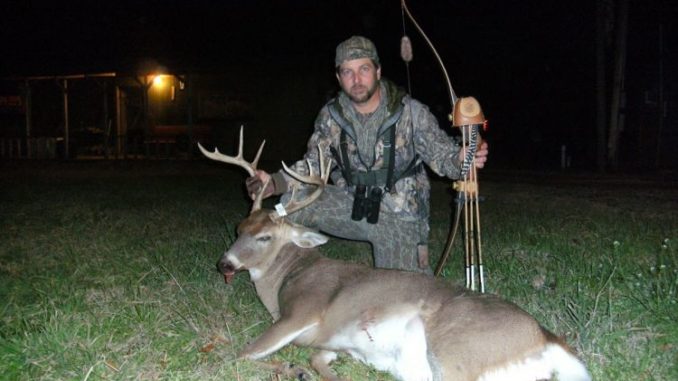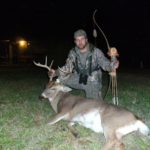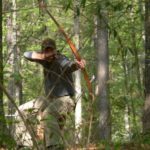
If you’re looking for a real challenge, try deer hunting with a longbow — where 20 yards is a long shot. It’ll push your woodsmanship to the limits and make you a better hunter.
A stick and a string — the only things standing between a traditional archery hunter and harvesting a whitetail.
It doesn’t get much simpler than that.
It’s quite a difference from the latest hunting equipment that often incorporates state-of-the-art technological tools and materials in their design. Nowadays, most hunters don’t enter the woods without a long list of gadgets to make it easier to harvest a deer.
Even compound bows go hand in hand with a slew of contraptions a hunter will never be caught dead without: rangefinder, mechanical release, carbon arrows, titanium broadheads, the list can and does go on.
Traditional archery hunters are the antithesis of the push to make hunting easier and more high-tech.
Now, that’s not to say traditional bows aren’t made with any modern materials, and arrows are often made of aluminum, fiberglass and even carbon.
But at the core of the sport lies a connection to a skill of years past, one where hunters rely on their whit more than a piece of technology — other than the one they hold in their hands.
Surrounding traditional archery is an unmistakable aura of minimalism, a quality Bobby Pagitt said drew him to the sport, which he described as a “purer form of archery.”
“When I’m in the woods with my recurve, I’m 75 percent lighter,” said Pagitt, who’s been hunting with traditional equipment for a decade. “I really don’t need a range finder. I know how far 20 yards is. I just go in lighter and keep it a lot more simple. That’s the thing about traditional — the simplicity of it.”
But don’t confuse simplicity with effortless. In addition to forgoing many modern improvements, traditional hunters must work longer and harder to become skilled while at times having less deer to show for it.
In other words, hunting with traditional archery equipment is the toughest way to bring down a whitetail.
Pagitt, who has hunted from Woodville to Tunica, La., tries to practice with his recurve bow nearly all year. The reason being that if he slacks off he knows he won’t be effective come hunting season.
According to Pagitt, being a consistent traditional archery marksman boils down to muscle memory and continued practice. There aren’t sights to aid with aiming on a traditional bow, so the user must shoot unguided.
Repetition ensures traditional shooters get comfortable enough to make an ethical shot when it counts, he said.
“The best way I’ve been able to explain it is it’s like throwing a baseball: how you look at the target and bring your arm back and throw the ball to the glove like a pitcher,” Pagitt said. “But instead, with the bow you look at the target, draw back, get to your anchor point and release.
“The farther you pull back the harder it’s going to get.”
Stephen Raggio, president of the Louisiana Traditional Bowmen club, expressed a similar sentiment.
“It takes a long time to become accurate because it’s an instinctive sport,” Raggio said. “A person can walk into a good bow shop and a man behind the counter will be able to fix him up with a compound bow, tune it up and within 20 minutes he can hit the bulls eye at 20 yards.
“It takes a few months to be able to do the same thing with traditional equipment.”
Raggio said traditional bows for beginners should have a draw weight of around 30 pounds. While the figure seems low, he underscored the fact that there is no letoff with a recurve or longbow. So when a shooter pulls back on the string he must hold the entire draw weight.
“When you shoot a traditional bow, you use muscles you may have never used before,” Raggio said. “So you have to build these muscles up. A lot of people buy 50-pound bows and try to shoot and can’t hit anything.
“Start off with a light bow and try to find someone who knows equipment to tune it. Since it is an instinctive sport, you have to have the bow tuned to the arrow to shoot properly.”
When the time does come for a shooter to release that arrow in a hunting situation, the target is usually within 20 yards, which for many hunters is the maximum range they’re comfortable shooting.
That adds another layer to the challenge, according to Raggio.
“It makes you a much better hunter,” he said. “You really have to get close to the animal. When the deer finally does get close, he might sidestep the arrow and he’s gone.
“It’s a hard thing to do.”
Arrow flight for many traditional bows is less than 200 feet per second, which means the farther the shot the more time the deer has to react to the noise after release.
“You have to position yourself and set up closer to animals,” Jay Curole explained. “You have to be smarter about hunting; you can’t shoot at 60 yards, and sometimes you can’t shoot at 30.
“My max range is probably 20 yards, and I’m most comfortable at 12 to 15 yards.”
There’s a lot working against a hunter when a whitetail is that close. At that point, everything comes into play: wind, scent control, camouflage and movement.
So Curole, who almost exclusively uses traditional archery equipment during deer season, said he’s become a better hunter and scouter. Knowing he’ll be a mere 10 or 15 yards from a deer when he has to make a shot forces him to intensely study an area he’ll be hunting to figure out exactly where a deer might be traveling.
“You have to change your tactics and mentality to a closer range, because that’s what you’re limited to,” he said.
Raggio, who near the beginning of the 2015 hunting season harvested two deer with traditional archery equipment from a ground blind, said he’s gained valuable information from watching deer that’s beyond his shooting range.
“You watch a lot of game,” he said. “You learn how game move. With a rifle, when you’re using a scope, if a deer walks out at 100 yards and you’re a decent shot (it’s) over—that’s it. With a traditional bow, when the deer walks out at 20 yards it’s just starting.”
Tim Mullins of Acadian Woods Bows in Slidell, La., has been making handcrafted bows considered by many to be works of art for more than 20 years. Mullins is widely known for his craftsmanship and has shipped his product across the United States and beyond.
Mullins said some many see traditional archery as entering the woods at a disadvantage, but he believes just the opposite.
“I believe that shooting a stick bow gives you advantages,” Mullins said. “You’re shooting instinctual or without sights, and it gives a huge advantage for the hunter. Low-light conditions aren’t issues anymore. You don’t necessarily think about yardage; your brain is your yardage computer.
“You can be just as good with a stick bow as you are with a compound bow.”





